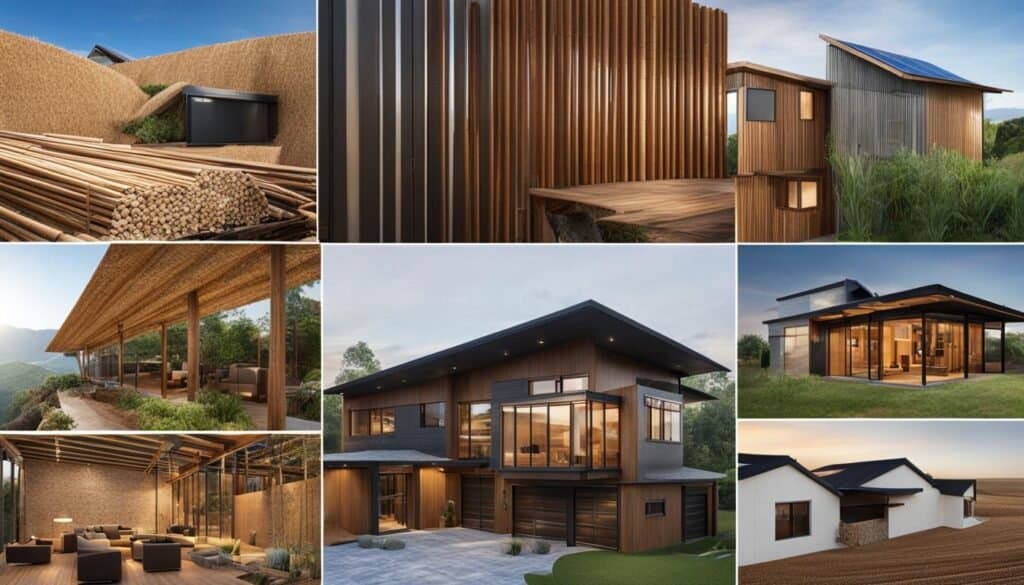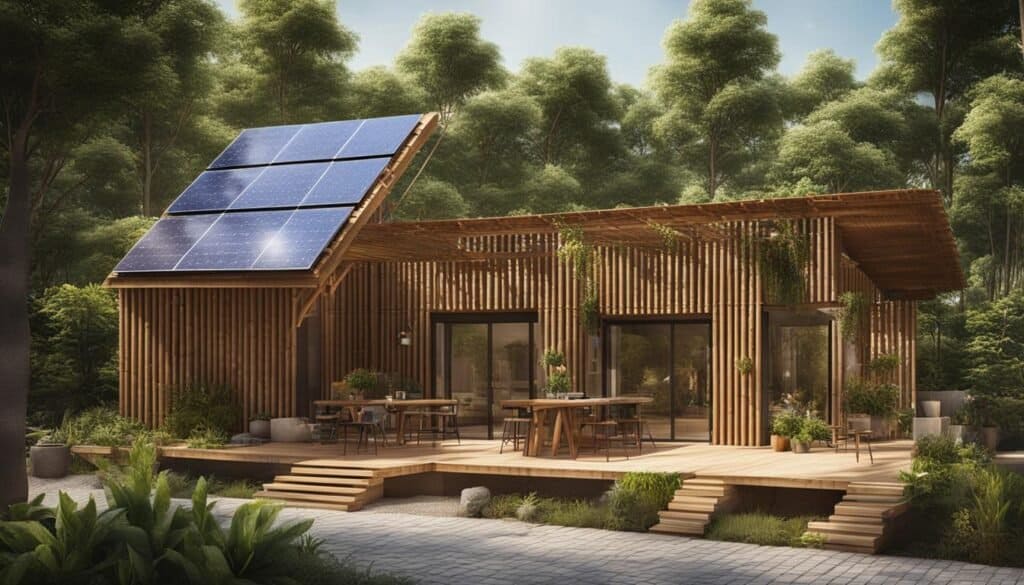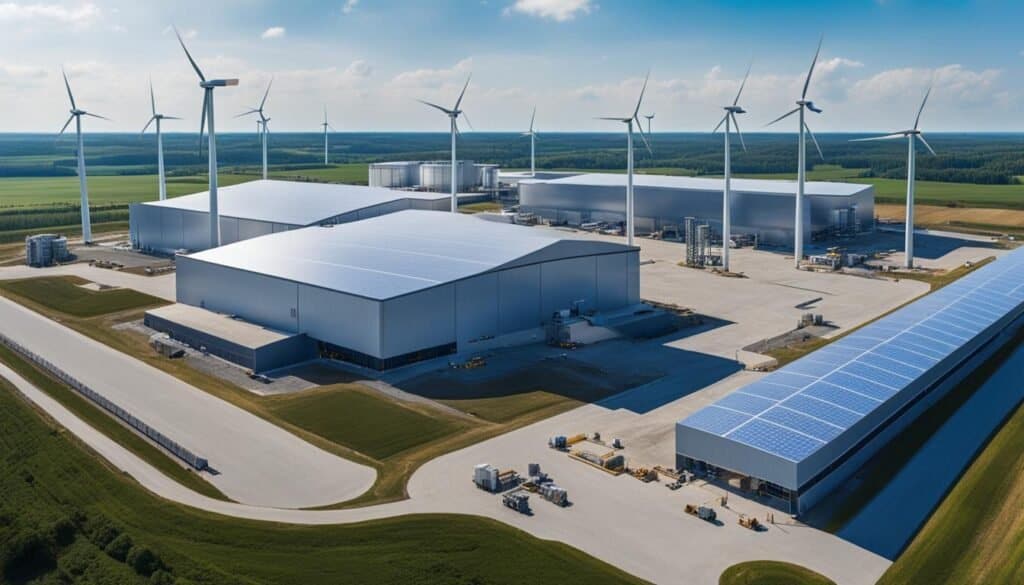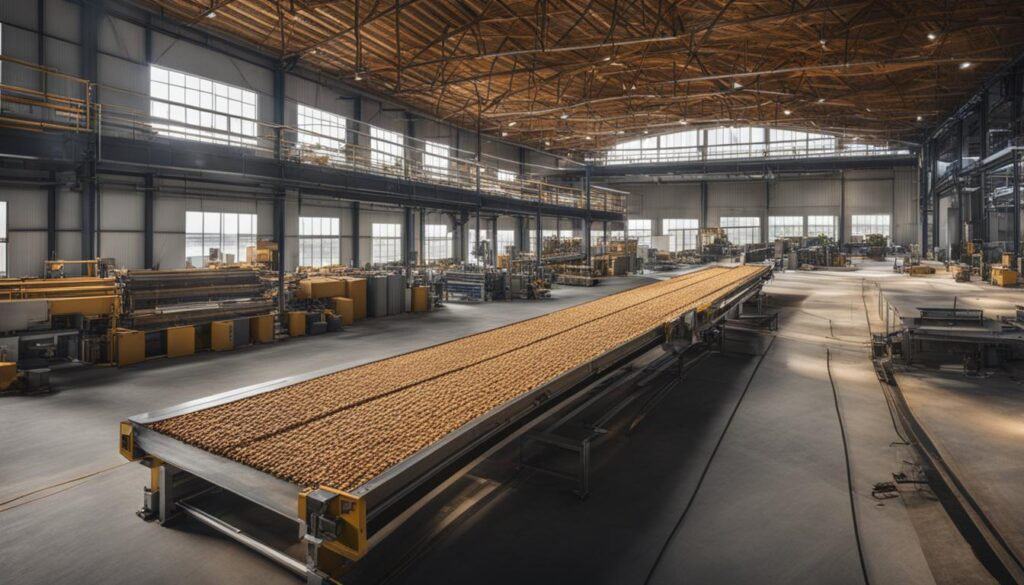As a professional copywriting journalist, I am often inspired by advancements in eco-friendly building and sustainable materials manufacturing. The use of green construction materials is revolutionizing the way we approach environmentally conscious construction practices. These sustainable resources not only provide numerous energy and cost-saving benefits, but they also help preserve our fragile planet.
I recently learned about a variety of innovative green building materials, ranging from renewable bamboo to carbon-sequestering Hempcrete, and it’s clear that these advancements are paving the way for more green building construction materials manufacturing. So, let’s explore what these materials have to offer and delve into the world of eco-friendly construction.
Key Takeaways
- Green construction materials are essential for promoting sustainable and environmentally conscious construction practices.
- Using sustainable materials such as bamboo, recycled steel, and natural insulations like sheep’s wool helps reduce energy consumption and waste.
- The shift towards eco-friendly building emphasizes the importance of resource efficiency and energy-saving methods like solar integration and passive design.
- Innovative materials like straw bales, Hempcrete, and low-VOC paints are transforming the future of sustainable construction.
- Employing green building materials results in numerous environmental and economic benefits, including reduced carbon footprints and cost savings.
- Industry leaders such as LafargeHolcim, Cemex, and Owens Corning are setting global standards for eco-friendly material manufacturing and technological advancements.
- Encouraging the use of sustainable materials and practices is key to fostering a greener, more resilient future in construction.
Top 21 Green Construction Materials
Here is a table outlining 21 eco-friendly and sustainable green building construction materials, along with their descriptions:
| # | Material | Description |
|---|---|---|
| 1 | Recycled Steel | Steel recycled from old buildings and cars. Reduces need for new mining and saves energy. |
| 2 | Bamboo | Fast-growing and sustainable, bamboo is strong and durable, ideal for flooring and structural elements. |
| 3 | Precast Concrete | Concrete cast off-site and transported for assembly. Reduces waste and ensures quality control. |
| 4 | Cork | Renewable and biodegradable, cork is used for flooring and insulation, providing natural thermal and acoustic benefits. |
| 5 | Straw Bales | Used as natural insulation material in walls. They are renewable, biodegradable, and provide excellent insulation. |
| 6 | Reclaimed Wood | Wood salvaged from old buildings, reducing the need for new timber and preserving forests. |
| 7 | Recycled Plastic | Made from post-consumer plastic waste, reducing landfill and not requiring new petroleum. |
| 8 | Rammed Earth | Compacted earth used for walls, natural and sustainable, with excellent thermal mass. |
| 9 | Ferrock | Made from steel dust and recycled glass, Ferrock is a sustainable and strong alternative to concrete. |
| 10 | Hempcrete | A bio-composite material made from hemp fibers mixed with lime. Used for insulation and as a building material. |
| 11 | Mycelium | Fungi-based organic material, grown to fit molds. Sustainable and biodegradable for insulation and structural components. |
| 12 | Ashcrete | Concrete-like material made from recycled fly ash. Sustainable and strong for construction. |
| 13 | Timbercrete | A mix of sawdust and concrete, lighter than traditional concrete and sustainable. |
| 14 | Wool Insulation | Natural sheep’s wool used as insulation, renewable, and energy efficient. |
| 15 | Solar Tiles | Roof tiles integrated with solar technology. They generate electricity while serving as traditional roof tiles. |
| 16 | Cool Roofs | Roofing designed to reflect more sunlight and absorb less heat, reducing energy costs. |
| 17 | Low-E Windows | Energy-efficient windows with a special coating to reflect infrared light, keeping buildings warmer in winter and cooler in summer. |
| 18 | Green Insulation | Insulation made from natural or recycled materials, reducing energy needs and improving indoor air quality. |
| 19 | Composite Decking | Made from a blend of recycled wood and plastic. Durable and low-maintenance alternative to traditional wood decking. |
| 20 | Non-VOC Paints | Paints without volatile organic compounds, better for indoor air quality and the environment. |
| 21 | Plant-Based Polyurethane Rigid Foam | Foam insulation made from plant materials, an eco-friendly alternative to petroleum-based foams. |
Each of these materials offers unique benefits and contributes to more sustainable and eco-friendly construction practices.
Embracing Sustainability: The Shift to Green Construction
The movement towards green construction highlights the significant trend in minimizing environmental harm through sustainable building practices and eco-friendly methods. Sustainable construction aims to address critical issues such as resource efficiency and energy consumption, creating buildings that align with the environment’s needs.
Blueprint For Better suggests prioritizing materials that reduce carbon, focusing on reuse, not just of materials but of existing structures. For new projects, incorporating salvaged materials from deconstructed buildings is beneficial.
Using materials like reclaimed wood and recycled concrete, and employing methods like solar energy integration and passive design, the green construction evolution promotes a holistic approach to construction, balancing human needs with planetary health.
Resource efficiency has become a primary focus for the construction industry, pushing architects, engineers, and builders to incorporate eco-friendly alternatives into their projects. By using sustainable materials and methods, the construction sector can significantly reduce waste, pollution, and overall environmental impact, leading to a brighter, greener future.
“The shift towards sustainable construction ensures that our growing population has access to healthy, affordable, and environmentally responsible living spaces for generations to come.”
Several factors are driving the eco-friendly construction shift, including:
- Increased global awareness of climate change and its consequences
- Government policies and incentives that encourage sustainable practices
- Consumer demand for healthier and more environmentally responsible living spaces
- Economic benefits of using sustainable materials and adopting energy-efficient solutions
As a result, sustainability has become an integral part of modern construction practices, with both residential and commercial projects adopting innovative green materials and methods.
| Material | Eco-Friendly Alternative |
|---|---|
| Traditional wood | Reclaimed wood or FSC-certified lumber |
| Non-renewable fossil fuels | Solar, wind, or hydroelectric power |
| Traditional paints and adhesives | Low-VOC paints and adhesives |
| Single-pane windows | Double or triple-pane windows with low-e coatings |
As we continue to embrace sustainability and prioritize ecologically responsible building methods, the construction industry is poised for a greener, more energy-efficient future. Investing in sustainable building practices and participating in the green construction evolution is crucial for the well-being of our planet and the quality of life for future generations.
The Definition and Purpose of Sustainable Construction Materials
Sustainable construction embodies the practice of designing and operating buildings in an environmentally responsible way, emphasizing the reduction of environmental impact throughout the material life cycle. Eco-friendly materials are defined by their sustainable sourcing, low energy production, and potential for recycling or reuse. They serve the purpose of resource conservation, reduced energy usage, and minimized waste production, solidifying the role of sustainability in modern construction.
Understanding the Lifecycle of Eco-Friendly Building Components
The lifecycle of eco-friendly building components spans from extraction to disposal, prioritizing energy efficiency and reduced environmental impact at every stage. By choosing renewable resources and recycling materials, the lifecycle of construction materials like bamboo and cork dramatically reduces the depletion of finite resources and carbon emissions associated with them.
“Sustainable construction materials not only preserve our planet’s resources but also save energy and reduce waste.”
The Role of Renewable Resources in Construction
Renewable resources play a critical role in providing alternatives for construction materials, offering options like bamboo and recycled plastics that regenerate quickly or divert waste from landfills. Their use significantly reduces the industry’s reliance on non-renewable resources and decreases greenhouse gas emissions during material extraction and processing.
- Bamboo: A quickly regenerating plant that can grow up to 3 feet per day, making it an ideal sustainable construction material.
- Recycled plastics: Constructing with recycled plastic materials saves resources and reduces the amount of waste in landfills.
- Reclaimed wood: Using wood that has been salvaged or repurposed from old structures conserves forests and offers a unique aesthetic appeal in building projects.
Adopting sustainable construction methods and materials is essential for contributing to a healthier and more eco-friendly planet.
Innovative Materials Shaping the Future of Eco-Friendly Construction

The future of green construction is being redefined by the introduction of innovative materials in eco-friendly building. With a focus on energy conservation, healthy indoor environments, and reduced dependence on traditional energy-intensive resources, these materials are setting the stage for a more sustainable future. In this section, we will explore some of the game-changing materials making waves in the industry.
Straw bales have become popular as a renewable, low-cost building material that provides excellent insulation. They are often used in wall construction, reducing the need for energy-intensive materials like concrete and steel while offering a natural, environment-friendly alternative.
Another groundbreaking material shaping the eco-friendly building innovations landscape is Hempcrete. Created by combining hemp fibers, lime, and water, this sustainable material offers excellent insulation and versatility. Its carbon-sequestering properties make Hempcrete a winner in reducing greenhouse gas emissions and promoting sustainable living spaces.
Moreover, the use of low-VOC (Volatile Organic Compound) paints has become increasingly popular in green construction projects. Traditional paints release toxic chemicals into the air over time, having a negative impact on indoor air quality. By choosing low-VOC options, builders can ensure healthier living environments for occupants.
The use of these innovative materials holds the potential to drive the construction industry towards more sustainable material advances, propelling global development while maintaining environmental integrity.
“Innovation is forging new pathways in the construction industry, as eco-friendly materials offer viable alternatives to conventional approaches. These materials prioritize energy efficiency, resource conservation, and sustainable living spaces, ushering in a greener future for all.”
To further highlight the potential of these innovative materials, let’s take a closer look at their benefits and impact on the industry:
| Material Type | Environmental Impact | Economic Benefits |
|---|---|---|
| Straw Bales | Renewable; excellent insulation; reduced need for traditional building materials | Low-cost; minimal transportation needed |
| Hempcrete | Carbon-sequestering; excellent insulation; sustainable raw materials | Energy-efficient; potential savings on heating and cooling costs |
| Low-VOC Paints | Reduced air pollution; improved indoor air quality | Healthier living environments; long-term cost savings |
Embracing these innovative materials in construction practices is essential for a more sustainable future. By prioritizing the use of eco-friendly options, the construction industry can make strides to combat climate change, ensure healthier living spaces, and contribute to a greener, more prosperous world.
The Environmental Benefits of Using Green Building Materials
Utilizing green building materials brings a myriad of environmental benefits, including resource preservation, waste reduction, and energy savings. These materials enable the creation of buildings that not only lessen the impact on the planet but also enhance its resilience through lowered carbon emissions and sustainable resource use. By prioritizing eco-friendly materials and construction practices, we can contribute to a more sustainable world while enjoying the advantages of green living spaces.
Reducing Carbon Footprint Through Sustainable Manufacturing
Sustainable manufacturing of building materials, like utilizing recycled steel or harvesting bamboo, drastically reduces carbon footprints. By saving energy costs and circumventing the need for virgin material production, the adoption of ecological materials focuses on improving the overall sustainability and efficiency of the construction industry. This sustainability-driven approach results in various positive environmental outcomes, outlined in the following table:
| Eco-Friendly Material | Environmental Impact Reducer | Benefits |
|---|---|---|
| Recycled Steel | Reduces mining for virgin iron ore and coal | Conserves natural resources and reduces carbon emissions in production and transportation |
| Bamboo | Regenerates quickly and sequesters carbon | Contributes to reforestation, mitigates climate change, and preserves biodiversity |
| Reclaimed Wood | Diverts waste from landfills | Preserves forest habitats and minimizes the need for new resource extraction |
| Low-VOC Paints | Decrease indoor and outdoor air pollution | Improves air quality, supports healthier living environments, and reduces ozone depletion |
Each green building material has its unique attributes for lowering environmental impact. Furthermore, there is a wide array of additional eco-friendly materials, like straw bales and Hempcrete, with diverse advantages and applications. Increasing the use of such materials can further contribute to the lasting benefits of environmentally responsible construction.
“The only way forward, if we are going to improve the quality of the environment, is to get everybody involved.” – Richard Rogers
As individuals, we wield the power to contribute to a greener future by supporting businesses and organizations committed to reducing the environmental impact of building materials. By incorporating sustainable choices into our lives and advocating for eco-friendly construction practices, we can collectively work towards preserving our planet’s resources and enhancing its resilience for generations to come.
Economic Advantages of Sustainable Building Materials

The adoption of sustainable building materials extends beyond the positive environmental impact they provide. They also present a number of financial incentives and cost-saving measures. Factors to consider include energy efficiency, local economic development, and reduced expenses in long-term maintenance and utility costs.
“Sustainable building materials not only benefit the environment but also offer various economic advantages such as cost-effectiveness and local economic stimulation.”
Reduced energy costs are one of the most significant economic benefits of green materials. The use of energy-efficient materials, such as wool insulation, contributes to a building’s overall energy conservation, which directly results in decreased utility costs for property owners and occupants.
There are also potential cost-saving benefits when sourcing eco-friendly materials locally or using recycled inputs. By doing so, transportation expenses can be minimized, and local economies benefit through increased job opportunities and investment in sustainable industries.
- Energy-efficient materials – By reducing energy consumption, materials like wool insulation offer long-term savings in utility costs.
- Local sourcing – Sourcing materials locally can reduce transportation expenses and contribute to local economic stimulation.
- Recycled inputs – The utilization of recycled materials not only benefits the environment but can also lead to cost savings in construction.
| Material | Financial Benefits |
|---|---|
| Wool Insulation | Reduced energy costs and long-term utility savings. |
| Locally Sourced Bamboo | Minimized transportation expenses and support of local economy and workforce. |
| Recycled Steel | More cost-effective alternative to producing virgin steel, reducing overall project costs. |
As the construction industry continues to embrace the diverse economic benefits of green materials, it becomes clear that the effectiveness and viability of employing these materials extend beyond their environmental impact. The financial impact of eco-friendly materials signifies that incorporating sustainable building materials into construction projects is not only a responsible choice for the environment but also a wise investment for a prosperous future.
Global Leaders in Green Building Material Production

Companies like LafargeHolcim, Cemex, and Owens Corning are setting the standard globally for green building material manufacturing. These industry leaders are integrating sustainability into their mission by reducing carbon emissions, developing low-carbon solutions, and aspiring to net-zero targets. They represent a growing trend toward ecologically responsible manufacturing and innovation in building solutions.
BuildSteel.org advises creating an inventory with a plan for all project materials, specifying low- or zero-carbon options, and setting targets for reducing, repurposing, and recycling these components.
Pioneering Companies in Eco-Friendly Material Manufacturing
Pioneering companies in green material manufacturing, such as Sika, Kingspan Global, and Vulcan Materials Company, provide innovative and sustainable solutions from energy management systems to rock wool insulation. Their leadership in integrating technological advancements with a commitment to sustainability reflects the industry’s direction toward eco-friendly practices.
| Company | Eco-Friendly Product | Key Benefit |
|---|---|---|
| LafargeHolcim | Low-carbon cement | Reduced carbon emissions |
| Cemex | Green concrete | Increased energy efficiency |
| Owens Corning | Rock wool insulation | Improved insulation performance |
| Sika | Green roofing systems | Reduced energy use and heat island effect |
| Kingspan Global | Energy management systems | Optimized energy consumption |
Integrating Technology and Sustainability in Material Production
The incorporation of technology in the production of sustainable materials, demonstrated by companies like Sherwin-Williams and St. Gobain, has led to advancements in roofing systems and rock wool insulation. Their products offer energy efficiency and environmental stewardship, showcasing how technology and sustainability complement each other in contemporary material production. Eco-Friendly Material Global Leaders, Green Building Manufacturing Pioneers, and Sustainable Material Industry Giants continue to showcase innovative approaches that prioritize both efficiency and ecological concerns in the construction arena.
“Our commitment to sustainability is core to our strategy and part of our long-term vision. By leveraging technology in material production, we can create products that are both efficient and environmentally friendly.” – John Surma, CEO of St. Gobain
- Reducing carbon emissions
- Developing low-carbon solutions
- Aspiring to net-zero targets
- Integrating advanced technology
In conclusion, today’s global leaders in green building material production are setting a high standard for sustainable construction. By reducing carbon emissions, creating low-carbon solutions, and aspiring to net-zero targets, these companies are making significant strides in shaping a more ecologically responsible future for the industry. As technology continues to advance, integrating sustainability and innovation will remain key factors in developing eco-friendly building solutions.
From Bamboo to Hempcrete: A Closer Look at Sustainable Building Materials

The sustainable materials industry has recently experienced remarkable growth as construction professionals and homeowners increasingly prioritize eco-conscious building materials in their projects. Among the wide array of sustainable materials available, bamboo and Hempcrete have emerged as two highly versatile and environmentally friendly options with numerous benefits. Let’s take a closer look at these unique materials and how they impact the future of sustainable building.
The sustainable materials industry includes a wide array of options, from the rapidly renewable bamboo to carbon-sequestering Hempcrete. These innovative materials display unique properties, such as bamboo’s high strength-to-weight ratio and Hempcrete’s insulation benefits, contributing to greener construction methods and the pursuit of sustainable living spaces.
Bamboo Building Advantages
Bamboo, often referred to as the “green steel” of the 21st century, has been gaining popularity in the construction industry due to its many advantages that make it an excellent alternative to traditional building materials. Some of the unique benefits of bamboo include:
- Rapidly renewable resource: Unlike timber species that may take decades to mature, bamboo can be harvested in just 3-5 years, making it a sustainable choice with a low environmental impact.
- High strength-to-weight ratio: Bamboo boasts a remarkable strength-to-weight ratio that exceeds that of some traditional building materials like steel and concrete. This impressive quality makes it ideal for various structural and non-structural applications.
- Low carbon footprint: Bamboo absorbs significant amounts of carbon dioxide during its growth, helping to mitigate greenhouse gas emissions. This feature contributes to the reduction of global warming and climate change.
- Biodegradable: Unlike synthetic materials that may persist in the environment for centuries, bamboo is entirely biodegradable, reducing waste and landfill clutter.
Hempcrete Construction Innovation
Hempcrete, a composite construction material made from hemp hurds and lime binder, is another innovative solution gaining ground in the sustainable materials industry. Its unique properties offer numerous benefits to the construction sector:
- Carbon sequestration: Notably, Hempcrete has the ability to absorb and store carbon dioxide from the atmosphere throughout its lifecycle, providing an effective means of combating climate change.
- Excellent insulation: Hempcrete excels at providing both thermal and acoustic insulation, thereby reducing energy consumption and promoting energy efficiency in buildings.
- Fire and pest resistance: Additionally, Hempcrete is naturally fire-resistant and unappealing to pests, making it a safe and reliable choice for construction projects.
- Non-toxic and breathable: Unlike many conventional building materials, Hempcrete is made from non-toxic components that promote healthy indoor air quality and allow moisture to be regulated, preventing mold growth and other potential health risks.
Both bamboo and Hempcrete are paving the way for the sustainable materials industry, offering eco-friendly alternatives to traditional construction materials. By harnessing the bamboo building advantages and Hempcrete construction innovation, we can contribute to more sustainable construction methods and create healthier, greener living spaces for generations to come.
Encouraging Eco-Conscious Building Practices for a Sustainable Future
As we collectively work towards a more sustainable future in construction, it is crucial to encourage eco-conscious building practices that prioritize energy efficiency, healthy living environments, and long-term sustainability. With a growing public awareness of the importance of sustainable development, the demand for green building advocacy is increasing as well.
One significant aspect of promoting eco-conscious building practices is the use of sustainable construction materials, such as sheep’s wool insulation and straw bales for wall construction. These materials not only minimize the environmental impact but also offer various advantages, such as renewable resources, improved indoor air quality, and reduced energy consumption. By choosing such materials, we contribute towards a greener future where ecological consciousness and innovation go hand in hand.
“The adoption of eco-conscious building practices is no longer a luxury but a necessity for our planet’s future.”
To further support this shift towards eco-conscious building practices, we can also advocate for policies and incentives that promote sustainable construction methods and embrace renewable energy sources. Organizations like the U.S. Green Building Council and the International Living Future Institute play a significant role in setting industry standards and offering guidance for sustainable construction.
Here are some essential building practices we can promote to foster a sustainable future in construction:
- Design buildings with energy efficiency in mind, including well-insulated walls, windows, and doors, and passive solar design.
- Utilize recycled and reusable building materials, such as reclaimed wood and recycled metals, to reduce waste and conserve resources.
- Incorporate renewable energy sources, like solar panels and small wind turbines, to generate clean energy for residential and commercial properties.
- Adopt a lifecycle approach, considering the environmental impact of construction materials and methods throughout the building’s lifecycle, from design to demolition.
In conclusion, eco-conscious building practices are vital for a sustainable future in construction, and it is our responsibility to advocate for and implement them. Let’s all work together to ensure that the buildings we create today leave a positive, lasting impact on our planet and future generations.
Conclusion: The Path Ahead for Green Building Material Manufacturing
As we witness the future of green building materials unfold before us, it is evident that eco-friendly manufacturing trends and a dedication to sustainable construction holds the key to a greener, more responsible industry. With growing global consciousness around the need for sustainability, the demand for innovative and environmentally-friendly solutions in construction continues to expand, driving the industry towards more resilient and sound practices.
In the pursuit of a sustainable construction outlook, industry leaders have been integrating sustainable practices, technological advancements, and prioritizing the minimization of environmental impacts. As a result, we see a rise in the use and development of materials like bamboo, hempcrete, and low-VOC paints. These cutting-edge solutions not only serve to decrease our carbon footprint, but they also lead to healthier, more sustainable living spaces.
Together, let’s continue to advocate for and encourage eco-conscious building practices throughout the construction industry. By doing so, we can ensure a brighter, more sustainable future for our planet and future generations. As we forge ahead on this path, we can expect to see even more remarkable innovations and advancements in the world of green building material manufacturing.
FAQ on Green Building Construction Materials Manufacturing
Q: What are eco-friendly building materials?
A: Eco-friendly building materials are sustainable alternatives to conventional materials, made from recycled or natural materials that have less impact on the environment.
Q: What types of materials can be used in eco-friendly construction?
A: Materials such as timber, reclaimed wood, recycled steel, rammed earth, plant-based polyurethane rigid foam, and salvaged materials can be used in eco-friendly construction.
Q: How are eco-friendly building materials manufactured?
A: Eco-friendly building materials are manufactured using sustainable methods that involve less energy and have a minimal impact on the environment.
Q: What is the significance of using recycled materials in construction?
A: Using recycled materials in construction reduces the need for new resources, minimizes waste, and helps in creating sustainable homes and buildings.
Q: Why is rammed earth considered an eco-friendly construction material?
A: Rammed earth is considered eco-friendly because it is a sustainable method that uses natural materials, requires minimal energy for manufacturing, and has a low environmental impact.
Q: How do eco-friendly construction materials contribute to green building practices?
A: Eco-friendly construction materials contribute to green building practices by promoting the use of sustainable, energy-efficient, and environmentally friendly products in construction.
Q: What are the benefits of using sustainable building materials in construction?
A: The benefits of using sustainable building materials include reduced environmental impact, energy conservation, and the creation of healthier and more eco-friendly living and working spaces.
Q: How does the manufacturing process of eco-friendly materials differ from conventional materials?
A: The manufacturing process of eco-friendly materials differs from conventional materials by prioritizing sustainability, using natural or recycled resources, and minimizing waste and energy consumption.
Q: Which types of buildings can incorporate eco-friendly construction materials?
A: Eco-friendly construction materials can be incorporated into various types of buildings, including new residential and commercial buildings, as well as in renovations and green home construction.
Q: Why should construction companies consider using eco-friendly materials in their projects?
A: Construction companies should consider using eco-friendly materials to promote sustainable practices, reduce the environmental impact of their projects, and meet the increasing demand for green and sustainable construction solutions.





Leave a Reply